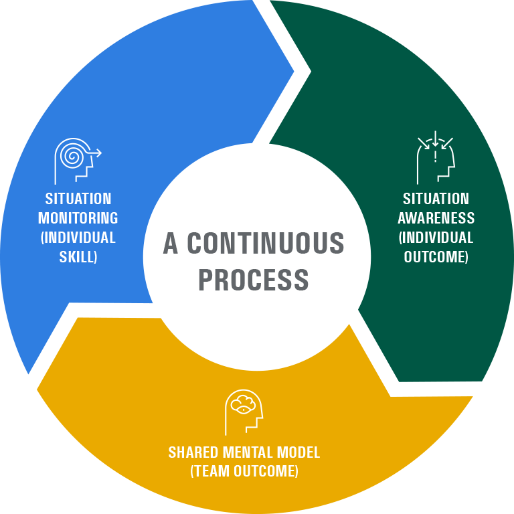At the end of the day, everyone wants to be part of an effective team that can guarantee the safety of the patients under their care. After all, patient safety isn’t just one person’s job—it’s everyone’s responsibility. When each person on the team practices Situation Monitoring and cultivates Situation Awareness through the TeamSTEPPS communication tools, the team can arrive at a Shared Mental Model where everyone has a shared understanding of what’s going on and what needs to happen next.
What is Shared Mental Model?
See It In Action
A central line must be inserted into the patient and Casey is the most qualified team member for the task. She delegates leadership to Randy, who is new to the department.
Why is it important for Casey to hand off leadership at this point?


What does a Shared Mental Model look like?
Here are some examples of how Situation Monitoring and Situation Awareness can lead to a Shared Mental Model.
Situation Monitoring can help teams adjust.
A physician notices that one of the nurses seems overwhelmed and calls for a huddle. The nurse explains that a particularly challenging patient is taking time away from the other patients under her care. Another team member offers to cover one of the nurse’s other patients to help ease the load.
The physician’s deliberate monitoring of the situation helped lower stress and balance the team’s workload.
Be proactive.
During a brief, a team reviews the list of patients they’re going to see before lunch. A medical assistant speaks up to point out that one of the patients is Spanish speaking and will need an interpreter. The MA offers to confirm whether there is an interpreter scheduled already, and if not, to schedule one for the patient.
The MA’s situation awareness and willingness to speak up brought everyone up to speed and avoided any miscommunication down the road
Use Situation Monitoring to look out for errors.
An assistant uses CUS to point out when a physician accidentally contaminates the field during a sterile procedure, and offers to get fresh drapes and gloves.
By monitoring the situation, the assistant was able to prevent a potential infection.
Help this patient care team arrive at a shared mental model.
Each individual working towards a Shared Mental Model will result in a coordinated, successful team.

Want to learn more about Project Firstline?
Contact ProjectFirstline@aha.org.
We value your feedback. Please complete this brief evaluation.


